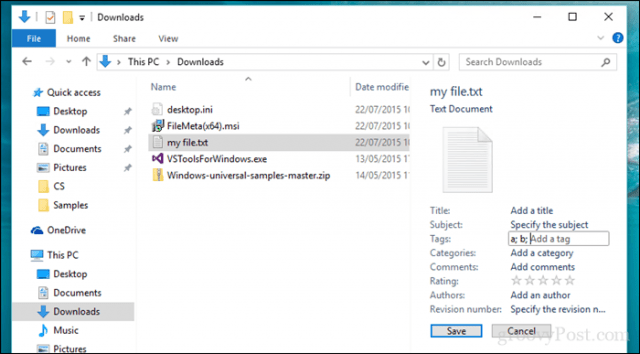How to Add Tags to Photos and Documents in Windows 10

Tagging your files in Windows 10 adds relevant descriptions that make your documents, photos and other types of data more accessible.
Tags can help make it easier to find and discover relevant information in Windows 10. Also known as metadata, tags describe the structure of information within a file. For example, when you tag someone’s face on Facebook, that’s metadata at work. Even here at groovyPost, we use tags to help identify our articles.
Operating systems such as Apple’s macOS have included tagging for many years, and Microsoft first included it in the Windows Vista operating system. With the overwhelming amount of information, we keep on our computers, making it searchable can go a long way toward helping us save time and be more productive. So, we will take a look at how you can use tags to help identify your documents, photos, and other types of files.
How to Add Tags to Files in Windows 10
For whatever reason, Microsoft seems to have buried tagging data in Windows 10, especially compared to previous Windows versions. Whether this is due to underutilization by users or a move to a more web-centric experience, tagging seems to be less prominent than it was in Windows 7 and Windows Vista. Nevertheless, it’s still there. So, let’s take a look.
First, launch File Explorer on the Taskbar or Start menu, open your Documents folder, or where ever you keep your files. Click the View tab, then toggle on the Details pane.


Now, you might notice something different about the way Windows 10 permits tagging of files. Not all files or file formats in Windows 10 will expose the option to tag them. The two images below, for example, are the same, but only the image in JPEG form will let you add tags. So, this is something you should keep in mind.




Once you have determined whether you can tag a file, you also need to determine what you should use for your tags. Tags must be descriptive yet simple for them to be effective. So, a picture of a beach, for example, could use descriptions such as location (Rio), date (1998), people in the photos (Mary, John, Suzy), event (Carnival). Remember to separate each word with a comma. These will greatly help when searching. After entering your tags, click Save.


Whenever you perform a search query, your results be more accurate and faster.


Tagging Other Types of Files – Microsoft Office Documents and PDFs
As I noted earlier, not all file formats permit tagging. Some applications only allow you to add tags from within the application itself. Take, for example, Microsoft Office files; these are files you likely want to tag so they can be easier to find and reference when you need them.
In Word or other Office applications, click File > Info. Within the Properties section, click in the Tags field, then enter the appropriate tags.


PDF files do not include the option to add tags, but you can resolve that with third-party solutions. One of the best ones I found is File Meta on CodePlex. With File Metadata installed, the following options are enabled in File Explorer for any file type—even basic text files. And it’s just 1.7 MBs.
- Allow the use of File Meta when there is already a property handler installed. The existing property handler is used to read existing metadata, but all new or updated metadata property values are written to the alternate stream store used by File Meta.
- The existing Preview Panel and Details properties are used as a starting point to which any other properties desired can be added. Before using this feature, I recommend reading Using the File Meta Association Manager to make sure you understand exactly what will happen and how to make it work for you.
- Support the configuration of the properties shown in the Info Tip displayed when the mouse hovers over a file in Explorer.
- Provide command line support for the capabilities of the File Meta Association Manager.
- Support 32-bit application access to File Meta property values on 64-bit systems. The application most commonly affected is Office. Source
After setting up File Meta, tagging will be enabled for other file formats in File Explorer, such as PDFs and text files.


Once you have a good system established, tagging can help you find your files on your computer.
Did you know about tagging in Windows? If not, let us know if you found it helpful for finding your files.
18 Comments
Leave a Reply
Leave a Reply







Matt
January 24, 2018 at 7:59 am
I have so many files on my system – this is useful for finding and keeping track of a specific file.
Paul English
January 24, 2018 at 2:32 pm
This was a huge help for me with my photos. I had been trying to figure out how to embed captions info in the metadata and this took me to that solution. Tagging is going to help me a lot with retrieval.
Rick Peat
January 25, 2018 at 6:01 pm
Thanks. I still would like to be able to tag other files, such as books, comics, etc. C’mon, Microsoft, it can’t be that difficult to open up a field for us.
Ron MVP
January 28, 2018 at 9:39 am
I tried tags as properties years ago, didn’t work for me.
So, instead of hiding them inside of file properties, I put my tags on the outside. I add “tags” to the start and end of the file name. And I use descriptive folder names to do high level grouping.
So I start with folder names like “Word tips”, “excel tips”, “Windows 10”, “Windows 8” etc.
Then I’ll add a “major” tag, say in the Win10 folder I have “feat” (Features), “Tweak”, “install”, “util” etc Then I add the article date 2018 01 01, then the full file name.
This way when I sort by file name all of the related files are sorted by date. So the “most relevant” one is newest date.
If I want to add more, secondary, tags, I’ll add them to the end of the file name.
I do the same with IE Explorer “Favorites”. (that is getting harder since most of the browsers are “improving” away from them.
To bring it all together, I use a standalone “file name search” tool called “e
verything” from Void tools.
The end result is that I can do “instant” searches for key words in file names for close to 20K Favorites and 30K files.
So when I search, there is no extraneous web search results. Just files on my local computer.
Charlie Spencer
June 28, 2018 at 5:29 am
The downside to this approach is that you can wind up with folder paths and file names that may be too long for Windows to successfully copy or backup.
Piet
April 17, 2018 at 5:28 am
Especially useful for example in accounting, where the same accounting document (voucher) needs to be retrieved from multiple angles (all invoices, all vouchers of a period, all documents of a customer of supplier, …) with one single (scanned) document stored.
Leihcim
May 8, 2019 at 1:06 am
I just ran into a solution that works for me. I can tag files multiple times without modifying the names and find them in the Explorer directly. I used something called “tagging for windows”. (because i accidentally ran into this tool and the url is hard to find: tagging.connectpaste.com)
Debbie V.
September 22, 2019 at 8:32 am
I did not know and it is great. I am wondering if the tagging will stick when I upload a photo to Google Photos or another cloud site.
Leihcim
December 25, 2019 at 4:09 am
Hi Debbie,
as far as i know documents can be tagged on a drive (C,D, etc etc).
the tagging will stick only if a file resides on a drive.
Marjan
December 24, 2019 at 2:52 am
This kind of tagging is the same as file name and not as much effective as only certain file types could be tagged. Not only it takes a lot of time but also it is difficult to find the tag. It would be much better if a sort of color tagging (like in MAC systems) was available so you could find a file sooner in a folder.
Leihcim
December 25, 2019 at 4:24 am
hello Marjan ,
Did you ask this via their support ?
My experience is that they are open to suggestions for extra features.
Leihcim.
Rod
December 28, 2019 at 9:08 am
PNG files are becoming much more in use. For example, “Chronicling America” by Library of Congress has great stuff for historical buffs, like searching very old newspapers. But downloading results in .png files. I need to be able to tag them in order to find the wealth of info contained. Even with Windows 10 this cannot be done and apparently that is a png standards issue with no near term sign of fixing.
There are third party programs that claim success but complicated. And I try to avoid new programs because of security issues with unknown providers.
Anyone have a working, practical solution? Dec 2019.
Leihcim
December 29, 2019 at 4:04 am
Hi Rod,
Did you try Tagging for Windows?
With the function Search and Tag it is possible to tag a lot of files at once. Maybe it helps?!
Kent Compton
May 26, 2020 at 5:21 pm
I recommend you use semicolons between tags instead of commas, that way you can search for a specific tag (tag:Rio) or mix multiple tags (tag:Rio tag:1998). Windows sees commas as a single string.
SHH
December 8, 2020 at 4:46 am
Finally clicked as to tags. Maybe one day they’ll make it easier to batch process, but still a useful feature. And thanks to Kent Compton for the bit on semicolons.
Eskdaleman
March 28, 2021 at 9:04 am
What a rigmarole! I tried adding tags like family trees etc where the system adds the semi-colon automatically. Clicked Save. Searching for family – no result, similarly with any tags I chose. I haven’t found a way to batch tag on any image editing app either: ACDSee has a seemingly good system but I have tried all ways to make it work and nothing happens; similarly with NCH Photopad, Affinity Photo. Nothing seems to work!
Leihcim
March 29, 2021 at 7:45 am
I agree with you. I personally use Tagging for Windows from that Dutch Company. It’s free, as I am informed, the Basic version which includes tagging in the Windows File Explorer, will stay free. I do not know if I can put an webpage address in here, but anyway: tagging.connectpaste.com
Jacko
April 14, 2022 at 12:15 am
On Windows 10, you can now easily change a png to a JPG image, but I’m having trouble when it comes to tagging the image, not sure if it was because it was originally a png or not. I did a test where I saved a png as a JPG, but it still wouldn’t let me add tags to the image. Its espicially annoying as something I’ve noticed on the internet lately is that images often save as a WEPB file, which is super annoying.
The reason why I want to use tags is so I can do rankings easily, such as TV show rankings, Movie rankings, episode rankings and character rankings.